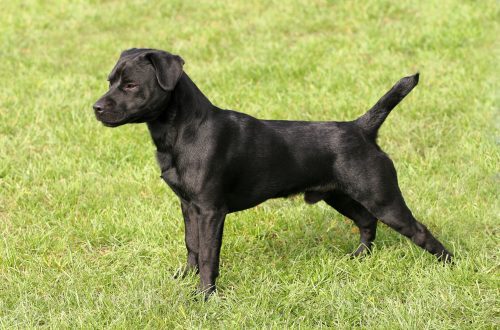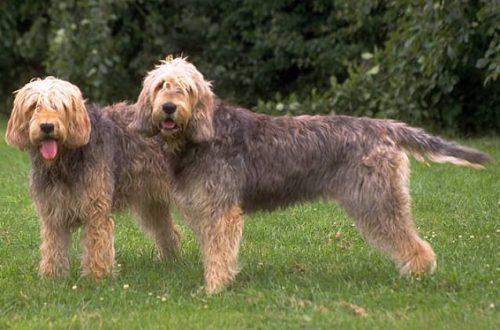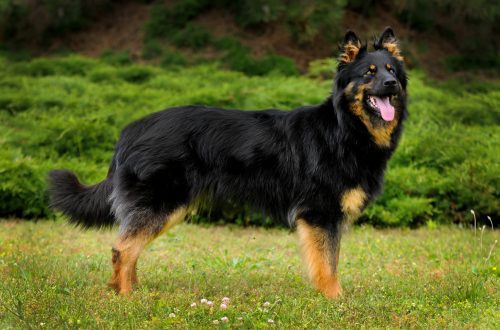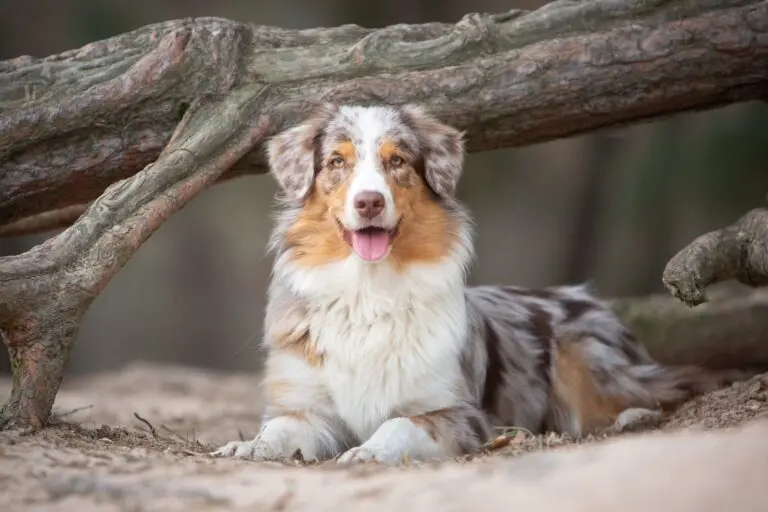
Aussie (Australian Shepard)
Contents
- Characteristics of Aussie Aussie (Australian Shepard)
- Pros and Cons of Australian Shepherds
- Description of the breed
- Aussie – Video
- Australian Shepherd Personality
- Tips for training and education
- Keeping and caring for Australian Shepherds
- Aussie food
- Health and disease
- History reference
- Photos of Australian Shepherds
- Who is this breed for?
- How to choose a puppy
- Photos of Australian Shepherd puppies
- Australian Shepherd prices
Characteristics of Aussie Aussie (Australian Shepard)
| Country of origin | USA |
| The size | large |
| Growth | 47–60 cm |
| Weight | 22–30 kg |
| Age | up to 13 years old |
| FCI breed group | herding and cattle dogs, except Swiss cattle dogs |
Brief information
- Another name for the Aussie is the Australian Shepherd. Despite this, it has nothing to do with Australia – this breed was obtained by a complex crossing of a collie and a Pyrenean sheepdog;
- Today, the Aussie is used both for herding purposes and as a companion;
- Australian Shepherds are great with children;
- Dogs of this breed do not make noise in vain, they bark only if there is a reason;
- Aussie is not suitable for those who live in the city and spend all day outside the house. This dog needs contact with the owner, long walks and runs.
Pros and Cons of Australian Shepherds
Australian Shepherd Pros:
- smart, grasp everything on the fly and lend themselves perfectly to training;
- very resourceful and able to make their own decisions;
- ready to participate in any undertakings;
- hardworking and hardy;
- get along well with children, can babysit and patronize them;
- friendly and devoid of aggression;
- can serve as guides.
Australian Shepherd Disadvantages:
- shed heavily;
- require prolonged physical exertion;
- cannot sit idle for a long time;
- they do not tolerate loneliness, they become attached to one person for life;
- vulnerable and touchy, may show jealousy;
- do not tolerate hot weather.
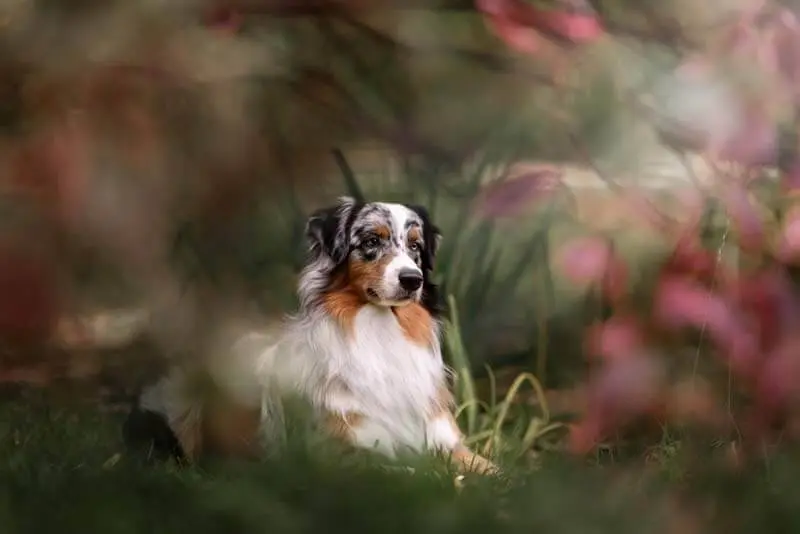
Description of the breed
The Australian Shepherd is easy to recognize by its appearance. Its exterior is similar to that of a Border Collie, with a well-built muscular body with a short tail, fluffy coat and bright eyes with an incredibly aware look.
Bitches look a little more elegant and graceful than males. But they are not thin-boned.
Head
Large in size, but does not seem bulky in relation to the body.
The skull has a slight rounding, the forehead can be either flat or rounded. On the back of the head, a bump is acceptable, but not pronounced. The depression between the nose and forehead is clearly visible. The line of the cranial vault is parallel to the bridge of the nose.
The muzzle is of medium length and has the shape of a cone, gradually tapering from the base to the bridge of the nose.
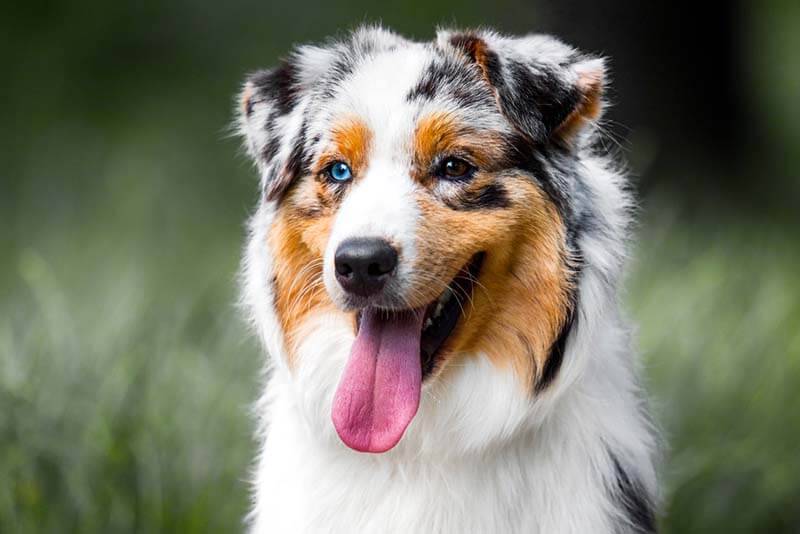
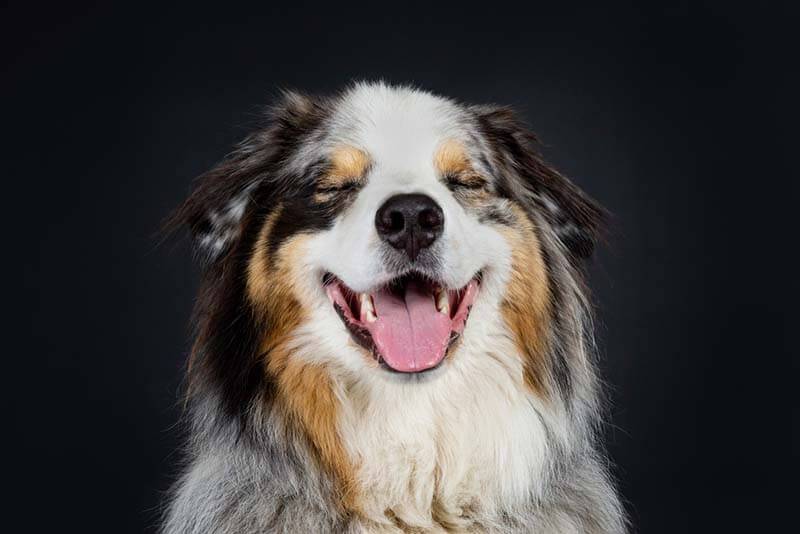
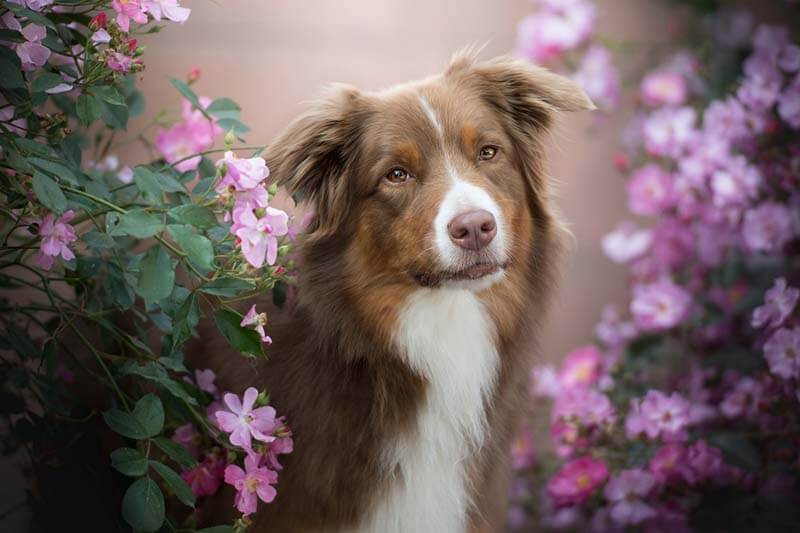
The nose is well pigmented. Its color depends on the color of the dog. A black earlobe can be found in dogs with a coat of a similar color or with a marbled blue coat. Brown earlobe is found in Red and Marbled Aussies. Also on it are acceptable small blotches of a pink tint. They should not be more than a quarter of the entire area of the lobe.
The jaws are strong, with a scissor or pincer bite. If overshot or undershot from three millimeters, the dog is disqualified.
The teeth are white, in a complete formula that counts forty-two teeth. Twenty of them are located on the upper jaw, and the remaining twenty-two are located on the lower. Ideally, all teeth should be in place. But the loss of a few of them due to injury does not disqualify the dog.
Eyes
Almond shaped, mid-rise. The color of the iris can be any: brown, hazel, green, blue. Marbling or inclusions of other shades are allowed. A different color of the iris of the eyes in one animal is not considered a defect. Dogs with black and marble-blue hair have dark “glasses” around the eyes. In red and marble-red dogs, it is a dark brown hue.
The look of the Australian Shepherd is conscious and expressive. She always watches with interest the person and what is happening around.
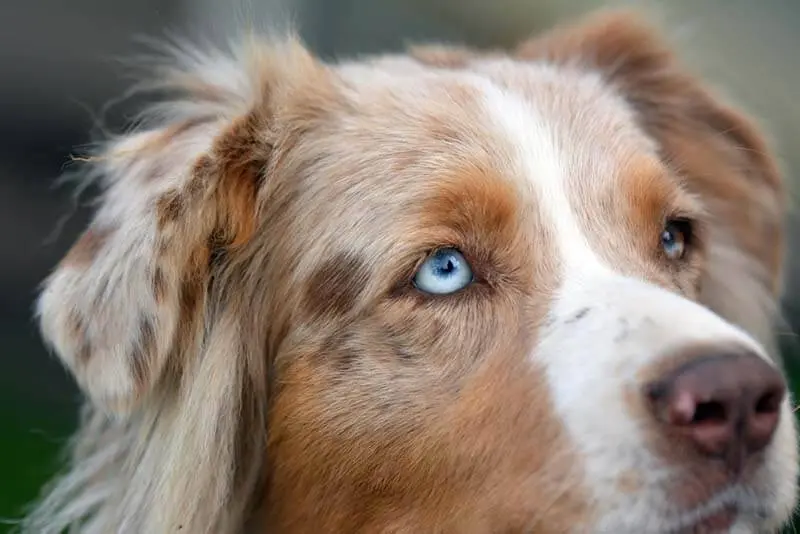
Ears
In the form of a small triangle with slightly rounded ends. They are located high, but not far from each other. Lateral placement is also allowed. But then the end of the ear should be directed forward. The ears are in a semi-erect position. When the dog is excited or alert, they rise. Fully hanging or erect ears are considered a disqualifying fault.
Neck
Well muscled, of short length, with a curve at the nape. Sits firmly on the shoulders.
Frame
Strong, with well-developed muscles. The width of the front is the same as the back.
The back is broad, with a straight topline, which, after the pelvis, merges into a slightly sloping croup.
The chest is shallow, with a well-visible relief. The lowest point is on the same level with the elbow joint. The ribs are elongated, the correct rounded shape.
The abdomen does not sag, is tucked up and has a moderate curve.
Tail
The Aussie tail can be of two types – long and shortened, up to ten centimeters in length. The second option will be noticeable at birth. The puppy’s tail will be short, and this is not considered a vice. Previously, a third type of tail was allowed – docked. But now such a procedure is prohibited in all civilized countries.
limbs
The forelimbs are characterized by flat shoulder blades, which are at a short distance from the withers. The angle of inclination of the blades is forty-five degrees. The length of the humerus is equal to the shoulder blade and stands at a right angle. The paws are strong and strong, in cross section they are oval in shape. The elbow joint is located in the middle of the segment between the withers and the ground. In movement, the forearms are perpendicular to the surface. The pasterns are not long, have a slight slope. The presence of dewclaws is allowed. The fingers are compactly assembled, the pads are dense, with elastic skin.
The hindquarters are well muscled. A perpendicular line can be drawn between the femur and the axis of the pelvis. Knee joints are well defined, have a bend in the region of the hocks. If you look at the Aussie from behind, then the shins will stand parallel to each other and be strictly perpendicular to the surface on which the dog is standing. Pluses are not long. Dewclaws are not allowed. The fingers, both on the forelimbs and on the hind limbs, are gathered into a ball and fit well to each other.
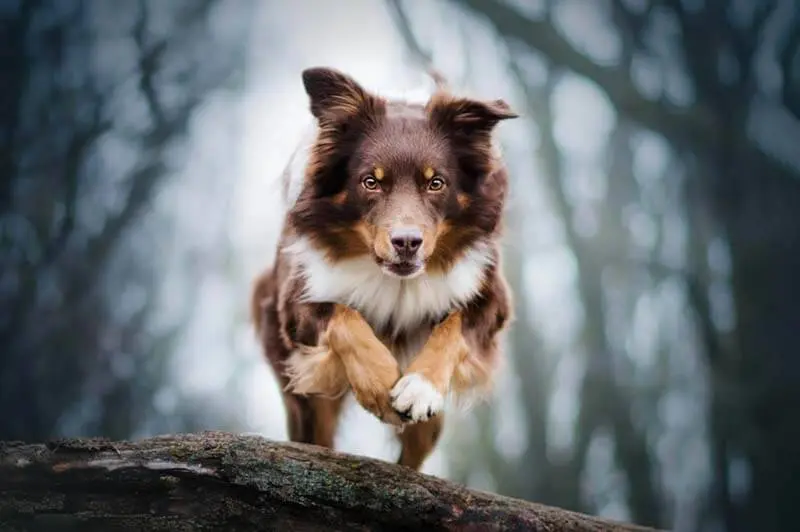
Gait
The movements of the Australian Shepherd are light and graceful. They are quite sweeping, but this does not affect the balance of the animal.
The fore and hind limbs move parallel to the central axis of the body. The faster the dog moves, the closer he puts his paws to the center of gravity of his body. The line of the back remains straight during the movement. If necessary, the Aussie can instantly change the trajectory of movement. This allows her to do innate agility.
Wool
The coat of the Australian Shepherd is quite thick. The hair is medium length and quite coarse. Most often – straight, but a slight waviness is allowed by the standard. The cover consists of two types of hair. Above is the backbone. It is long and dense, serves as a kind of “umbrella” that protects the dog from precipitation. Under the guard hair is densely stuffed soft and fluffy undercoat. It keeps the dog warm in cold weather.
The undercoat is completely changed twice a year. Its abundance depends on the conditions in which the dog lives. If it is a cool climate, then the undercoat will be very dense. If the year is dominated by hot days, then it will be more rare. Shedding in periods after the change of undercoat is characterized as moderate.
On the muzzle, ears and some parts of the limbs, the hair is short. There are so-called “feathers” on the body. These are long guard hairs that grow on the back surface of the forelimbs and the gluteal zone. There is a small mane and collar. At the same time, they are more pronounced in males.
colors
The colors of Australian Shepherds are varied. Like human fingerprints, they never repeat. But officially the standard recognizes only four colors of wool cover:
- black;
- marble blue, which is more common than others;
- red;
- red marble.
In all of the above colors interspersed with white spots are acceptable, but they should not be too much. The older the dog gets, the darker its coat will be.
In nature, sable, golden, brindle or graphite colors can be found. But they are not recognized by the standard, therefore they are considered a marriage.
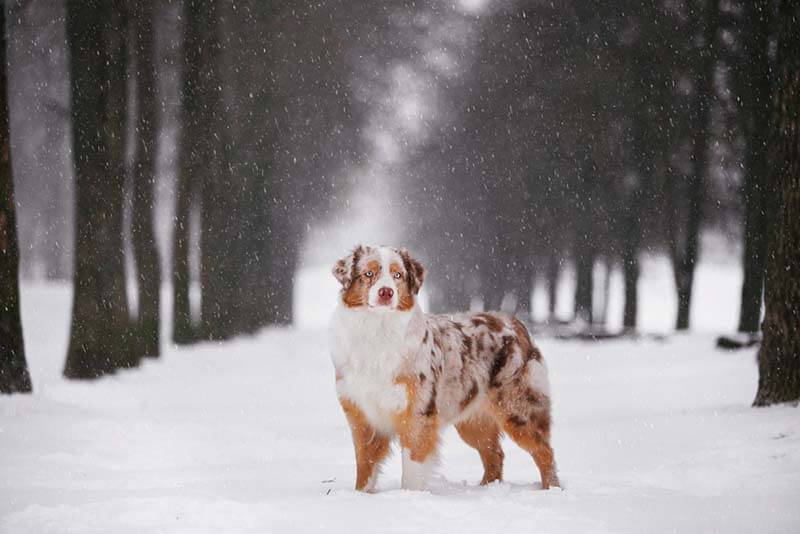
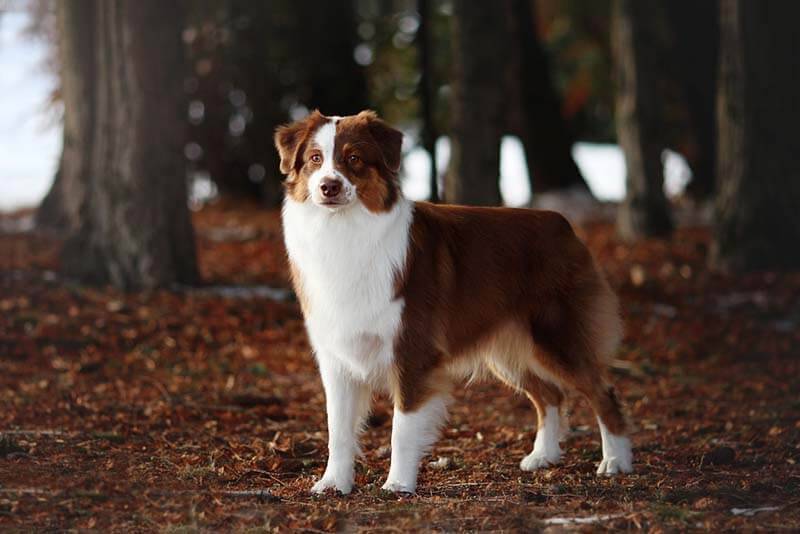
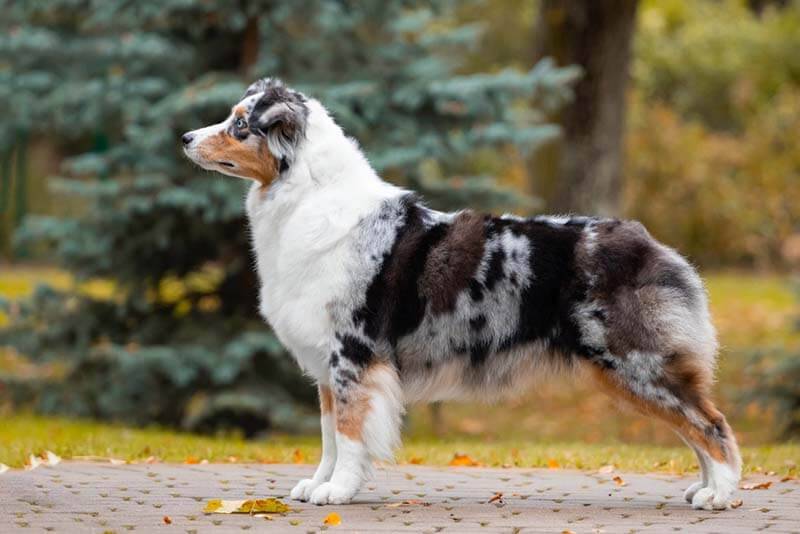
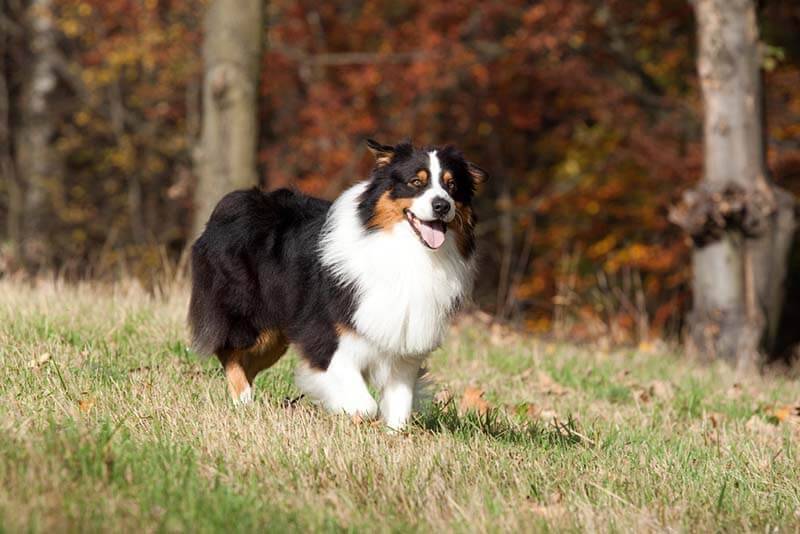
Size and weight
The Australian Shepherd is a medium dog breed. At the same time, females are somewhat smaller in size than males. The height of the “boys” can be from 52 to 58 centimeters at the withers. The indicator of “girls” ranges from 46 to 53 centimeters. The weight of a male dog is from 23 to 29 kilograms. Souk – from 18 to 25.
Aussie – Video
Australian Shepherd Personality
Australian Shepherds were originally bred as work dogs, as helpers and loyal friends to farmers and their families. Currently, they are still responsible shepherds and devoted companions, they love to work very much and are happy to be near the owner.
Aussies are balanced, energetic and active. They are very affectionate and cheerful. Representatives of the breed perceive training well , joyfully meet new tasks and perform them perfectly. It is very important for them that the owner pays attention to them and praises for their help. If the pet is left at home alone, then he will definitely get bored and begin to spoil things and furniture.
Aussies love children and are great friends with them. But with strangers, Australians behave somewhat wary. But they are friendly with other dogs, they behave wonderfully at exhibitions and on walks.
More communication with their owner, these dogs love only active games with him. This is the kind of breed that will happily run outside in rain, snow and sleet. She will relentlessly wind circles in the stadium or overcome the obstacle course over and over again. And if the owner is present at the same time, then there will be no limit to the happiness of the animal. By the way, the Aussie is a dog that can “smile” when it sees someone from its family. She does not hold zest for life.
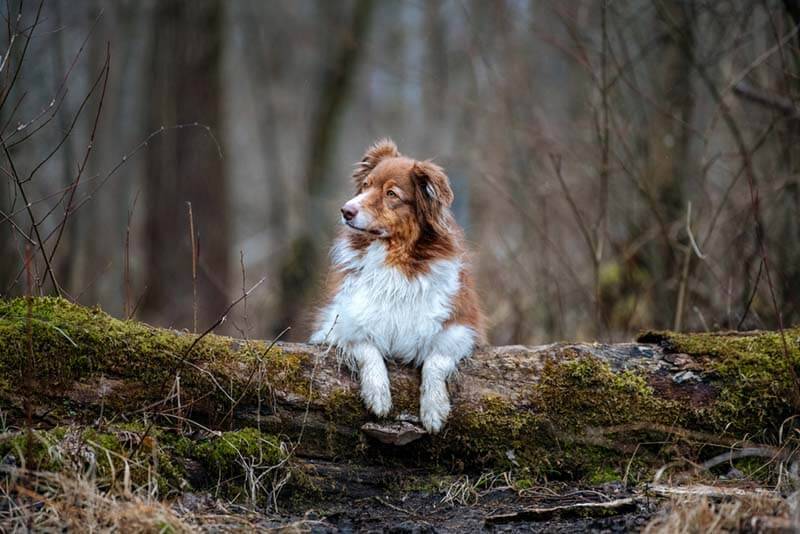
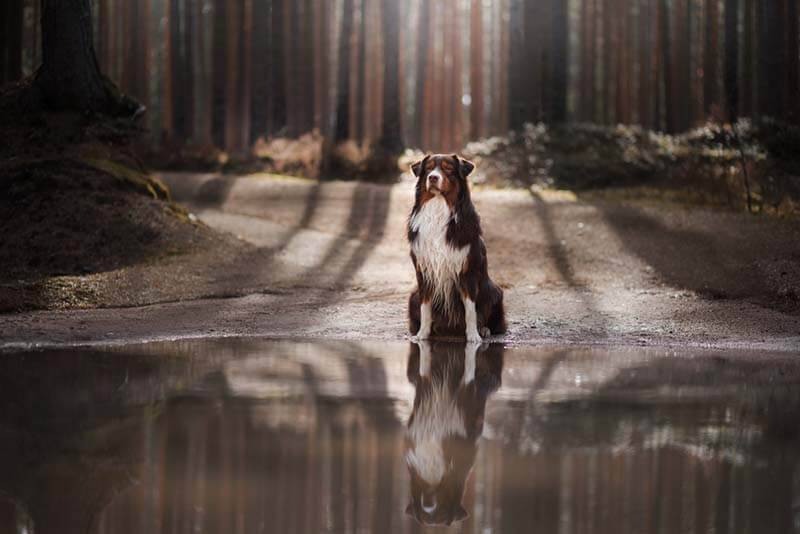
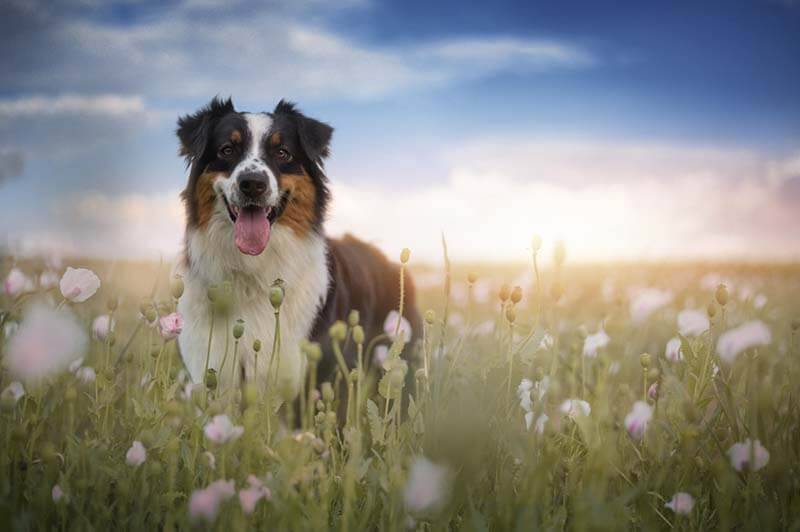
Tips for training and education
In the veins of the Australian Shepherd flows the blood of a born guard. If you do not pay due attention to the training and upbringing of the dog, then it may be too aggressive, protecting its territory. Such behavior should be treated with increased caution. Aussies are friendly and affable by nature, should not show aggression. Like cowardice, it is considered a deviation in the behavior of the animal.
As soon as the puppy appears in his new home, explain to him the rules of behavior. First of all, he must learn what he can and what is strictly prohibited. Such a line of behavior will allow the “child” to quickly get used to and feel comfortable in a new place.
The dog must understand who his master is. If you do not show it right away, then the smart Aussie will try to take a leadership position in your relationship with her.
This breed is intellectual. Her mental abilities are great, and the dog can be easily trained in any commands. The talented Australian Shepherd will catch them on the fly. On average, a dog learns a new trick in 30-40 repetitions, which is a very high figure.
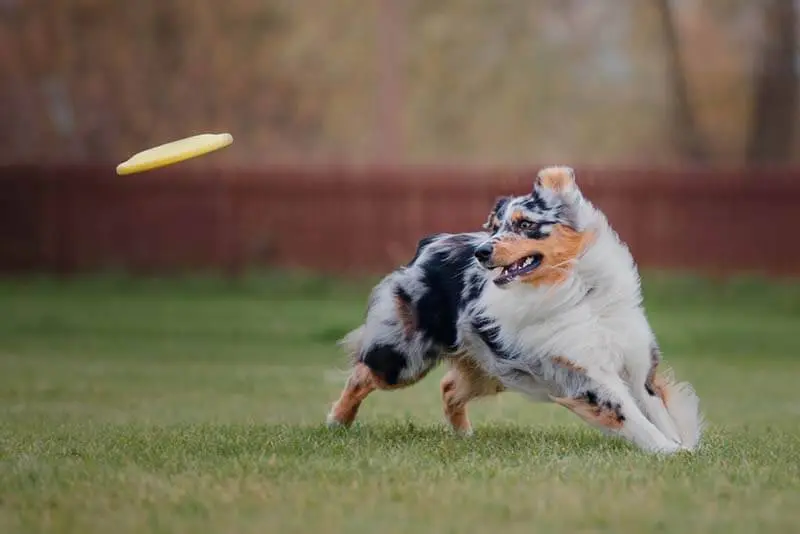
It is better to start training at home. First of all, learn commands such as “stand”, “come to me”, “no” with the puppy. This will keep him safe outside. Then the training can be continued in the fresh air. So you can combine business with pleasure by combining a walk and a workout.
It is very important to give your pet the motivation to exercise. After each correctly executed command, praise the dog and give it a treat. Australian Shepherds are very greedy for treats, so they will be happy to work out for goodies.
Outdoor activities help your dog improve concentration. So the dog develops the habit of not being distracted by external stimuli. Before you start training, give your pet the opportunity to just run around, sniff around and do his doggy “things”. Then he will be completely focused on the execution of your commands.
Do not scold or punish the Aussie if the dog does not understand or refuses to comply with the request. In this case, you need to show perseverance and patience. If you yell at the dog, he will become fearful or stubborn. Australian Shepherds are very sensitive and can take offense at their owners.
If you find it difficult to cope with training on your own, then it makes sense to seek help from a professional dog handler. With an instructor, you can take a general obedience course, as well as take separate lessons for training with a dog. Australian Shepherds learn quickly, so a few sessions are often enough.
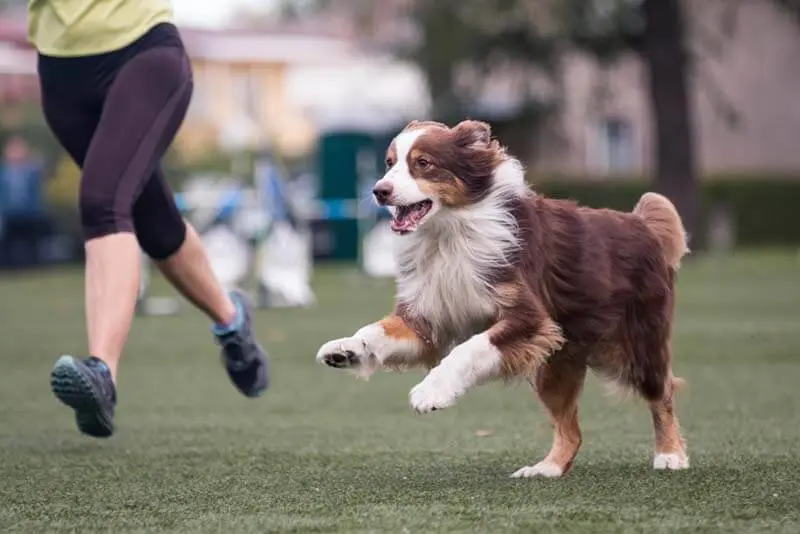
Keeping and caring for Australian Shepherds
Aussies have a medium length coat. Shedding occurs abundantly, seasonally. If the air in the room where the dog lives is dry, then the molting process takes longer.
It is advisable to bathe the shepherd dog once a month or as it gets dirty, using special shampoos. If the pet lives on the street, then in winter he does an excellent job of cleaning the coat, rolling in the snow. And in the summer you can organize a trip to the river and swim there. After that, the dog must be rinsed with clean running water.
If the pet is kept at home, then you can bathe it in the bathroom, after putting a rubber mat on the bottom so that the paws do not slip off. After water procedures, the wool should be wiped well with a towel and can be dried with a hairdryer.
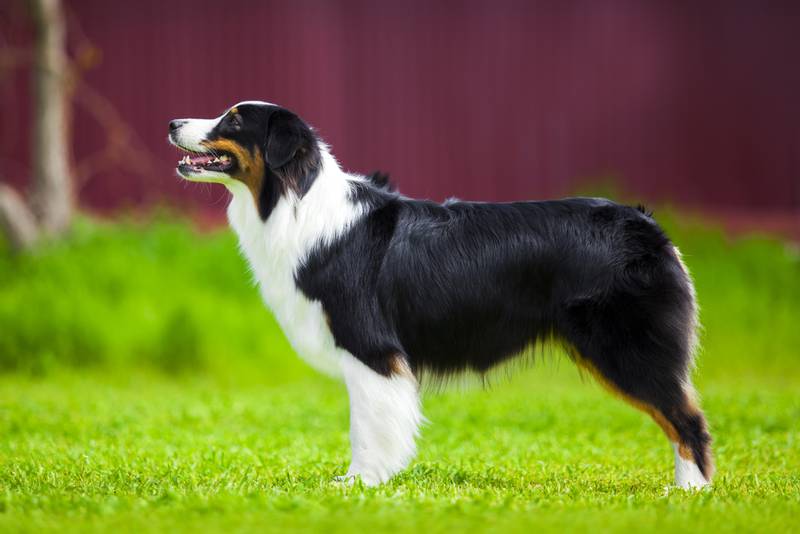
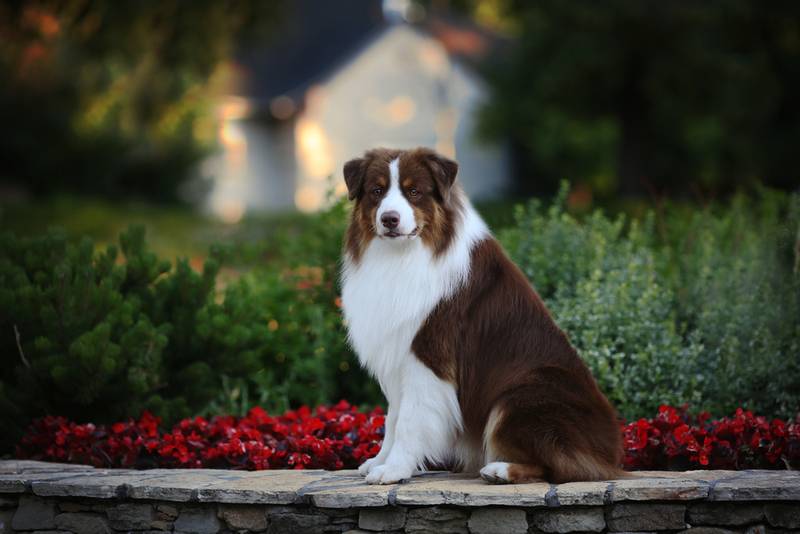
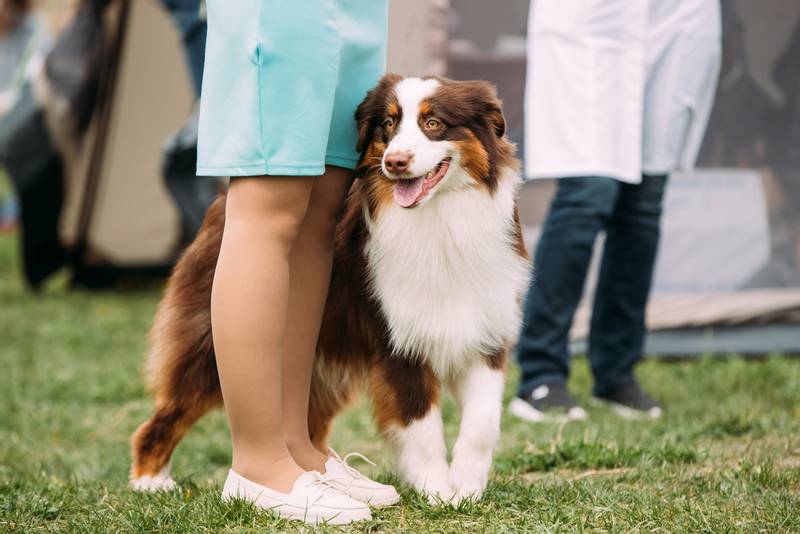
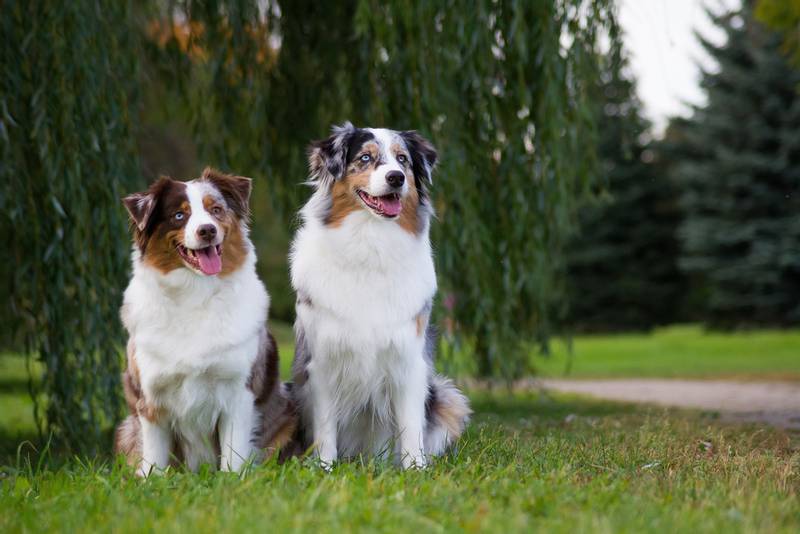
Combing an Australian is recommended a couple of times a week with a brush or comb. It perfectly removes fallen hairs and also improves blood circulation. During the molting period, this procedure should be carried out more often.
At least once a month it is necessary to trim the dog’s claws using a nail cutter.
Dog teeth also need care, you need to monitor their condition and take your pet for preventive examinations to a specialist.
Australians are by nature active and mobile, they are able to run several tens of kilometers a day, so it is unbearable for them to be in an enclosed space all day. In order for them to maintain health, well-being, to maintain the right muscle tone, shepherd dogs need outdoor games in the open.
They constantly need to be provided with a variety of physical activities, taught obedience, commands , play sports, training for performances at exhibitions. Jogging or cycling will not be boring with them, and you can safely take them with you on walks, hikes and picnics.
Aussies can also be kept outdoors, for example, by building a spacious aviary for her . Australians adapt well to frost, rain and hot weather. But it is important to remember that this dog cannot be put on a chain: she needs the opportunity to move freely.
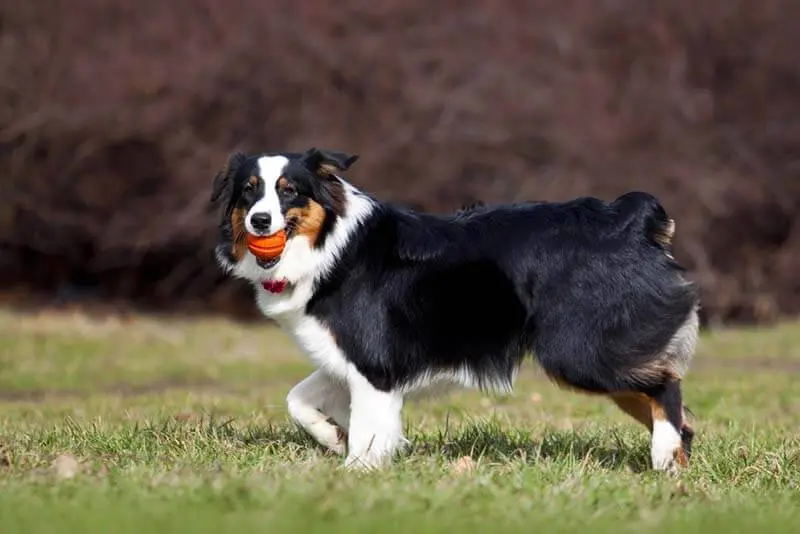
Aussie food
Industrial feed is an excellent choice for formulating an Aussie diet. If possible, you should choose premium, super premium, and holistic food. They contain all the necessary nutrients, vitamins and minerals.
You can not feed the dog the same food throughout its life. Manufacturers produce lines for puppies, adult animals and old people. There are options for lactating bitches, as well as dogs suffering from various diseases. All of them differ in their composition.
Australian Shepherd Dry Food is a complete and balanced diet that has been formulated with your four-legged friend in mind. No homemade food can compare with industrial food.
When choosing food for Aussies, pay attention to its composition. It should contain proteins and fats of animal origin, vegetable components, cereals. But flavors and flavor enhancers should not be there.

The Australian Shepherd is an active dog breed. It should not be overfed, as obesity is detrimental to the health of the animal. Lack of food will also negatively affect him. Muscle tissue and skeleton will not be able to develop and form properly. It is important to observe not only a sufficient number of calories, but also a balance of nutrients. And to provide it with natural products is almost impossible. Therefore, leading veterinarians recommend dry and wet food.
An adult Australian Shepherd should be fed twice a day – in the morning and in the evening. Do this after a walk, so as not to overload the gastrointestinal tract of the animal. If you decide to feed your pet with dry food, then he must always have access to drinking water.
It is strictly forbidden to feed a dog from a common table. This not only forms a bad habit of begging for food, but also negatively affects the health of the animal. Food that is suitable for humans is not suitable for dogs. It has a lot of salt, sugar and other additives that are detrimental to the dog.
Health and disease
If you provide an Australian Shepherd with decent nutrition, a high level of physical activity and care, then it may well become a long-liver. And in order to avoid most deadly diseases for dogs, it is necessary to give your pet all the necessary vaccinations in a timely manner.
Most herding breeds are prone to developing juvenile cataracts. Aussies are no exception. In addition, they may more often than others suffer from the following diseases:
- autoimmune diseases, including allergies;
- vision problems, optic nerve dystrophy;
- epilepsy;
- hip dysplasia;
- malignant tumors;
- skin diseases, demodicosis.
Merle-coated dogs are prone to blindness and deafness. Such a defect is congenital and may arise due to a recessive gene that is associated with this color, as well as hearing and vision. To avoid such troubles, breeders do not cross two individuals with a merle color. Otherwise, the risk of the birth of completely deaf and blind puppies increases.
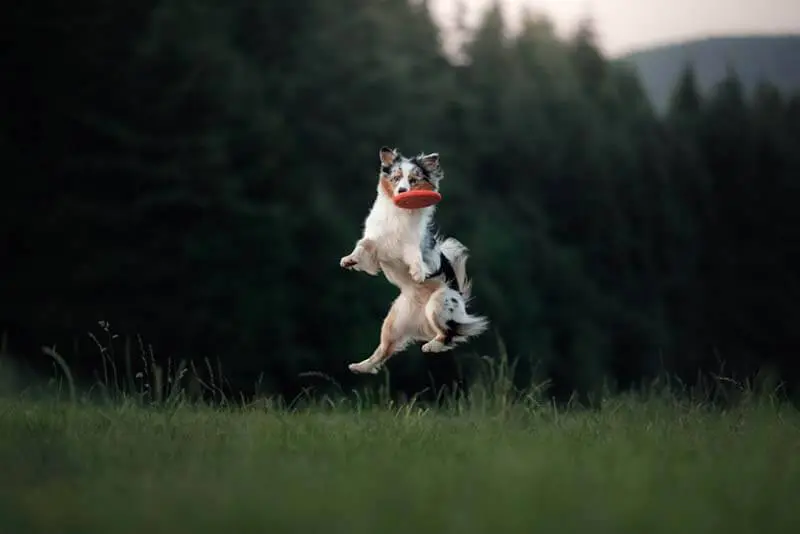
History reference
Historians have studied the origin of the Australian Shepherd literally up and down. But they could not come to a consensus on this issue. It is generally accepted that the history of the appearance of the Aussie originates in Australia, and is associated with the name of Eliza Forlong, but the first representatives of this breed were bred in America.
Eliza Forlong settled with her family in eastern Australia in the early nineteenth century. They set up a farm and started raising sheep. And they were grazed by shepherd dogs, which are now commonly called old German shepherds. From them the first ancestors went – the Aussies, who appeared in Australia.
There is another theory. It says that the ancestors of the Australian Shepherd are coolies, which are very similar to modern Aussies. To breed ideal shepherds, farmers crossed them with cattle dogs. Participated in the creation of the breed and border collies, as well as tigers.
When the wool market began to develop in the United States, Aussies were also brought there from Australia. These capable and amazing dogs quickly earned the love and respect of Americans. This country is considered the birthplace of the Australian Shepherd, as it was in it that the first official breeder was registered. They became Juanita Elli, who played a significant role in the spread of the breed.
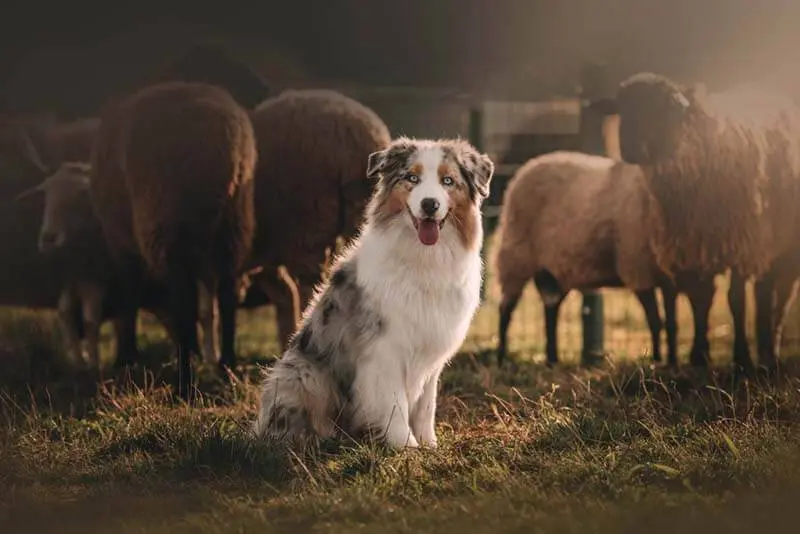
The popularity of Australian Shepherds has increased thanks to Jay Sisler. He performed at the rodeo with his three Aussies, who performed incredible tricks. Animals have even been featured in several films.
The history of Australian Shepherds is also associated with farmers named Hartnagle. They were looking for good shepherds for their flocks of sheep and chose Aussies. It was their dogs that became the parents of Jay Sisler’s dogs.
The first officially recognized Australian dog was registered in 1957. Her name was Panda. It was a huge breakthrough for the breed and its first independent step in the world of cynology. In 1962, the first club dedicated to the Aussies was registered. In 1970, two nurseries appeared, and a few years later there were 26. But the breed standard was adopted only seven years later.
Photos of Australian Shepherds
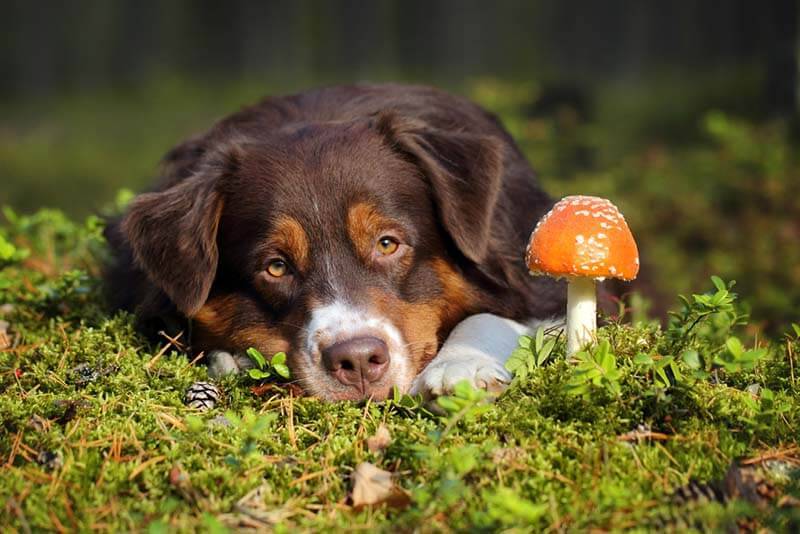
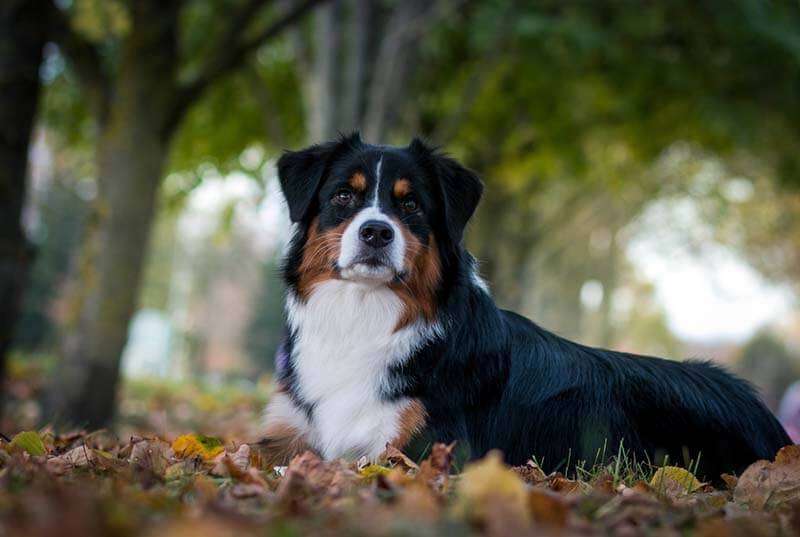
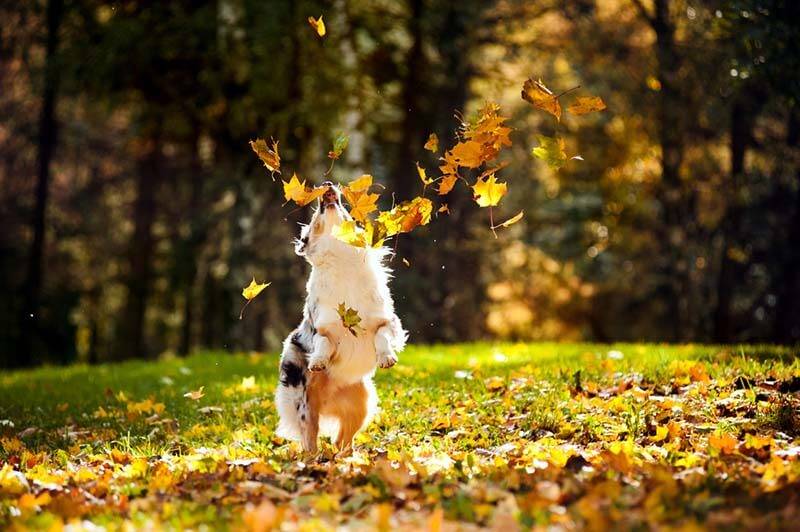
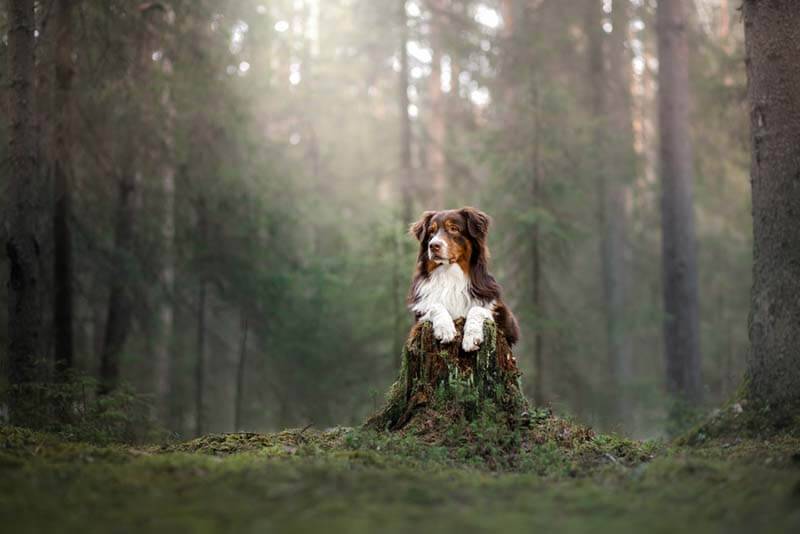
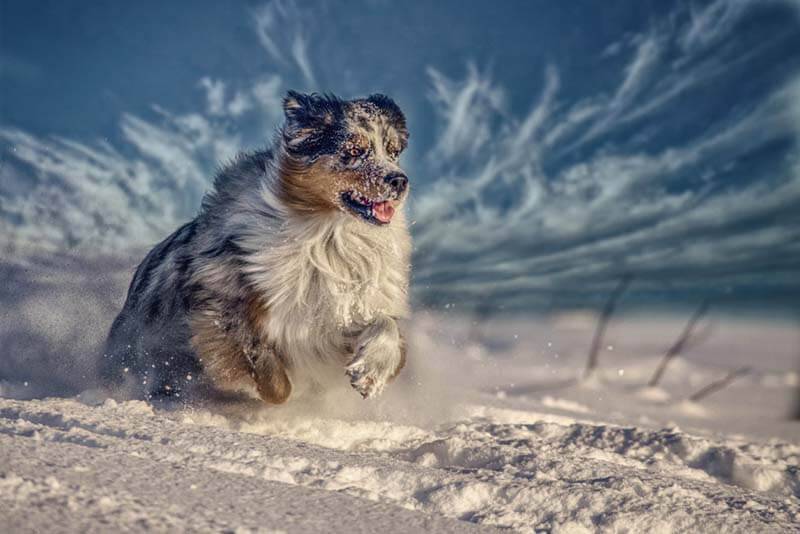
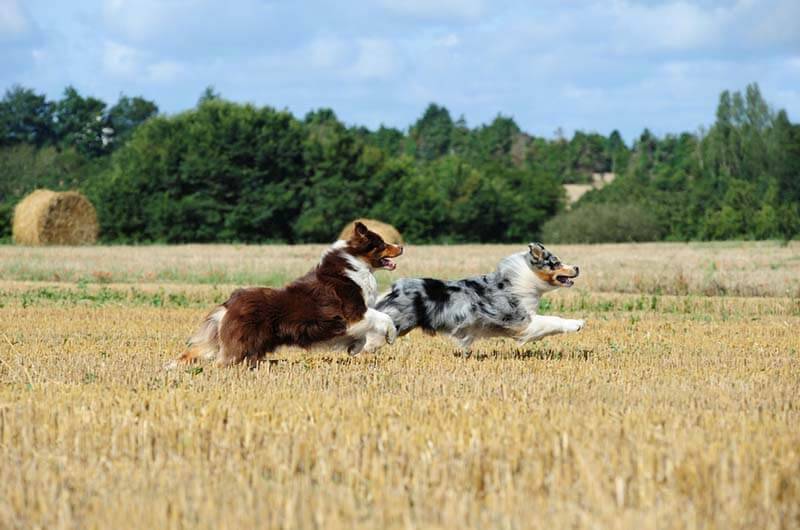
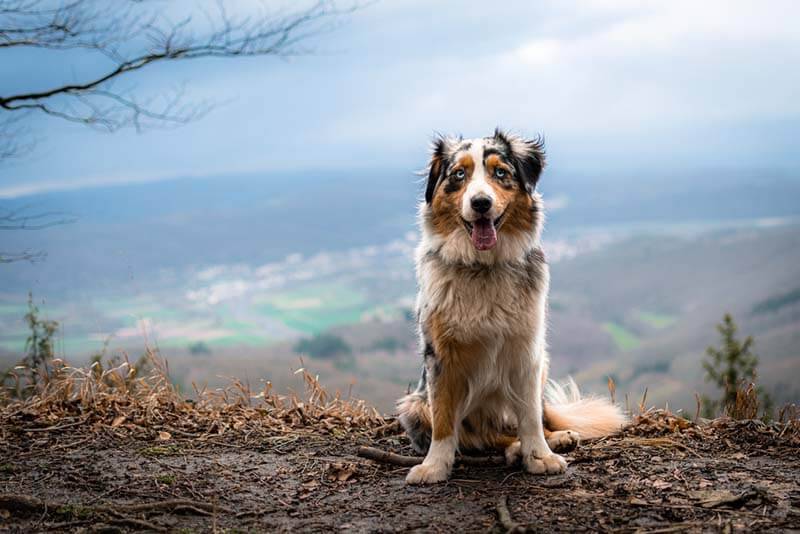
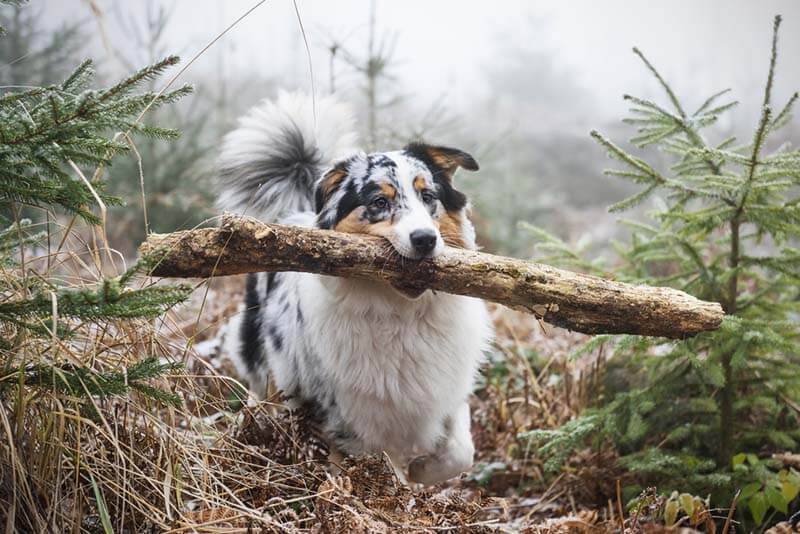
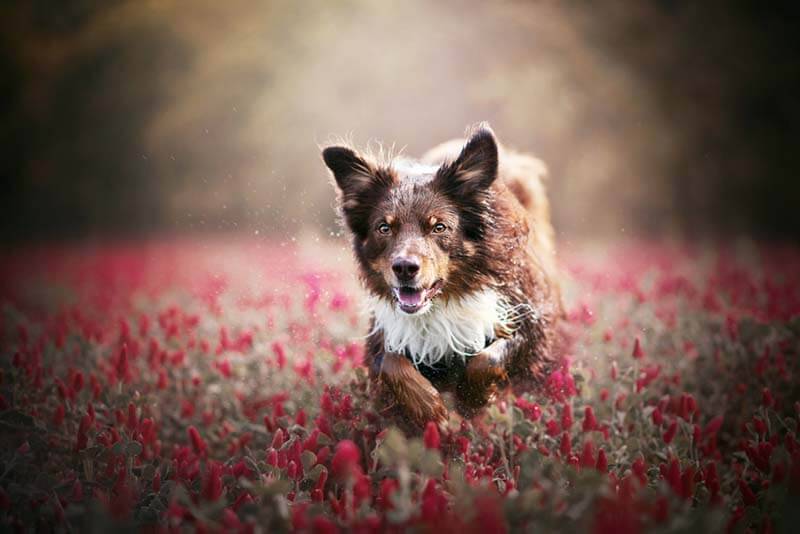
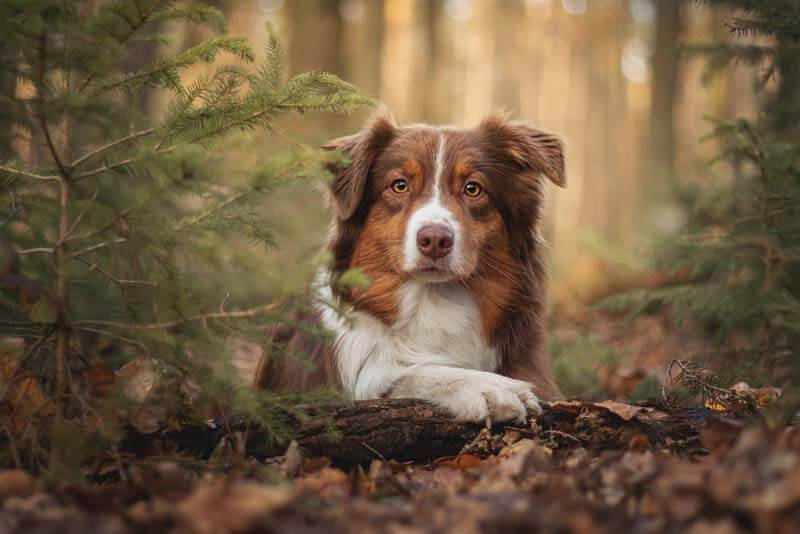
Who is this breed for?
Australian Shepherds are often bred because they are very attractive in appearance and are famous for their high level of intelligence. But not everyone understands the responsibility they take on by getting such dogs. Aussies are not for everyone.
If you like to spend your free time at home on the couch watching movies, then this breed is not for you. And for those who love hiking, walking in the fresh air, cycling and running, the Aussie will gladly keep company. It is important for this dog to move a lot, as well as spend enough time with the owner.
Your temperament should match the temperament of the dog. Aussies are very energetic dogs. Therefore, if you want to walk with a four-legged friend with a calm gait in the park, then it is better to buy a representative of decorative dog breeds. With the Australian Shepherd you need to run, jump, throw the ball. And you need to do this for as long as possible.
These dogs tend to be independent. They can make decisions without the owner’s command. If a person does not know exactly how a dog should behave, then it will decide for him. At the same time, he will take the initiative in his “paws” and be a leader in relationships.

Aussies will feel great in a private house, where there is an area for free range. But she can also live in an apartment if you are ready to walk with her for at least a few hours a day. It is important for the dog to have contact with the owner, to spend more time with him. Australian Shepherds are not doing well in isolation.
It is not difficult to take care of the dog’s coat, but you need to devote a lot of time to regular combing. You will also have to put up with an abundance of hair on furniture and clothes during periods of molting.
This breed is suitable for families with children. Aussies get along well with kids, participate in their games, can become guards or nannies. But other animals can be problematic. The developed instinct of the shepherd can make the dog chase the living creatures.
The Australian Shepherd will become a devoted friend for you if you spare no time for its upbringing, strength for walks and training, and patience for training.
How to choose a puppy
Before you give money for a puppy, you must be sure that you have made the right choice. To do this, visit several exhibitions where this breed is represented. Ask all your questions about her breeders. A puppy is, first of all, a responsibility.
If you are determined to get an Australian Shepherd, then visit several kennels where these dogs are bred. Take an interest in the pedigree and health status of the puppy’s parents. The baby must have all the necessary documents and a veterinary passport.
Before choosing one of the puppies, watch them. A healthy dog should be well-fed, with a shiny coat, clean eyes and ears. Give preference to a kid who frolics and explores the world around him with interest. He should not look scared or, conversely, show aggression. The best animal will be the one that makes contact with you without fear.
Photos of Australian Shepherd puppies
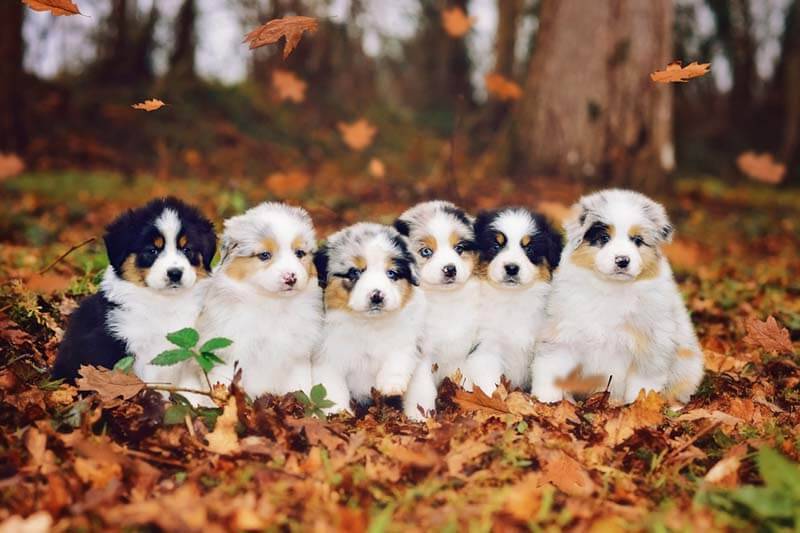
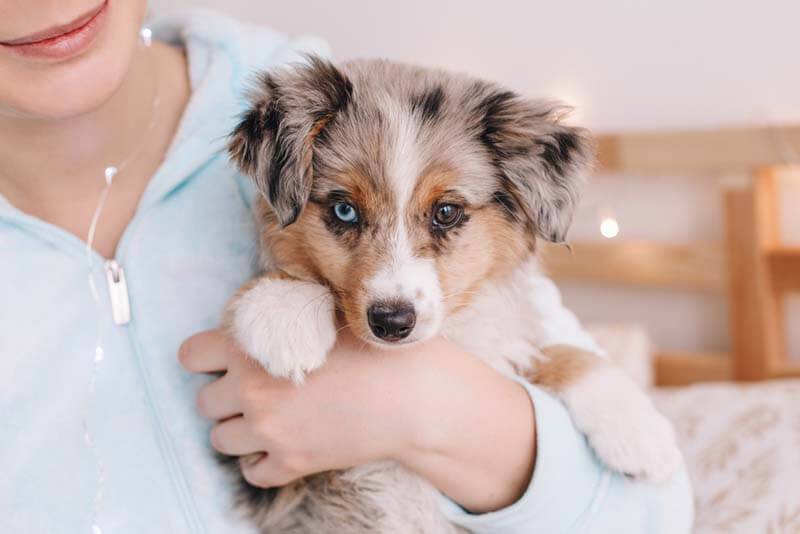
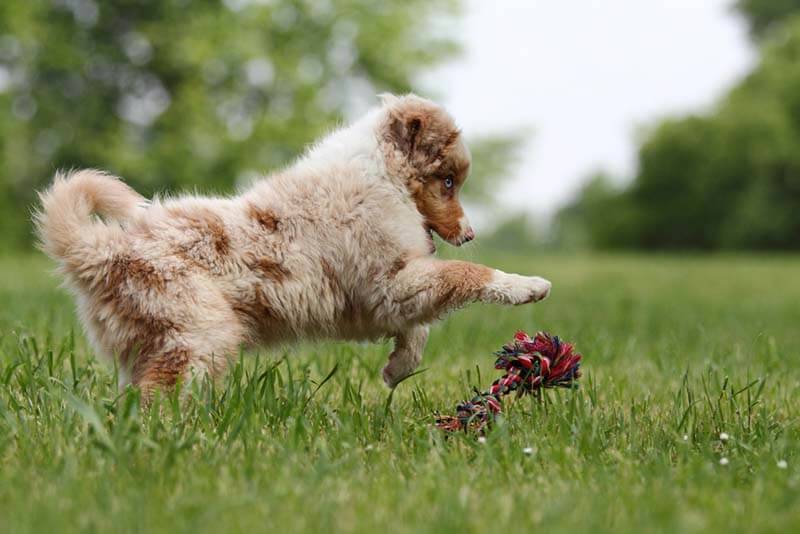
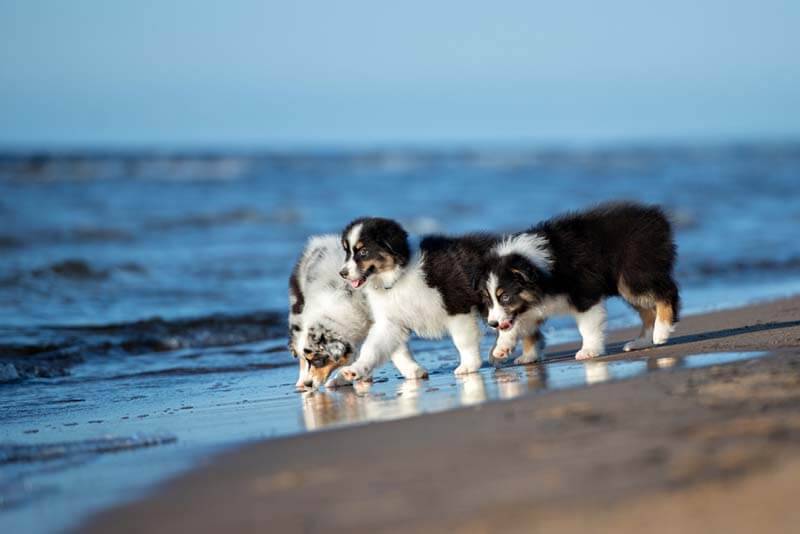
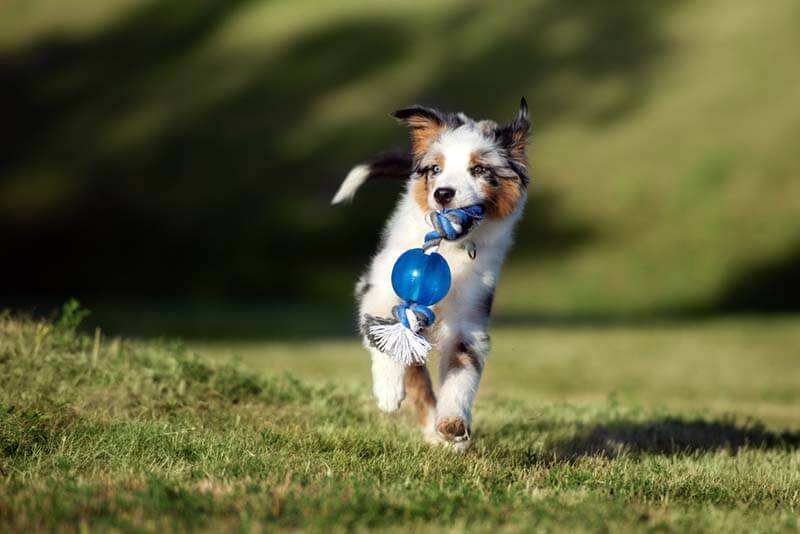
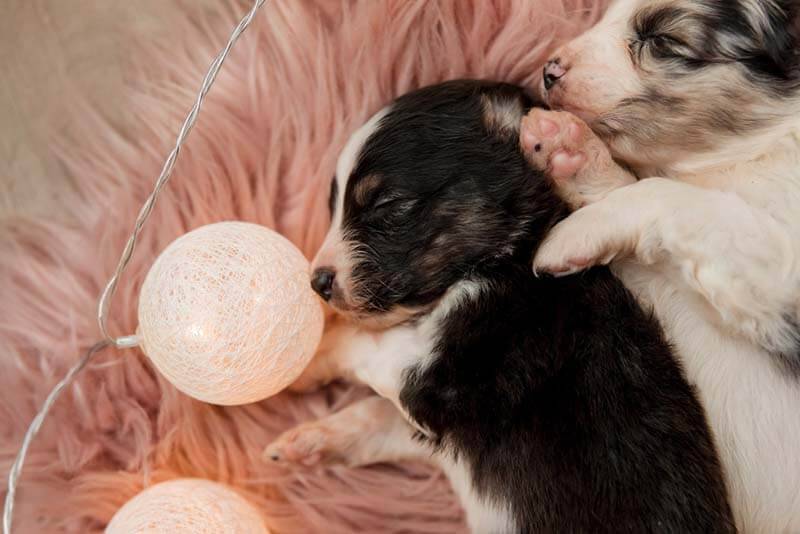
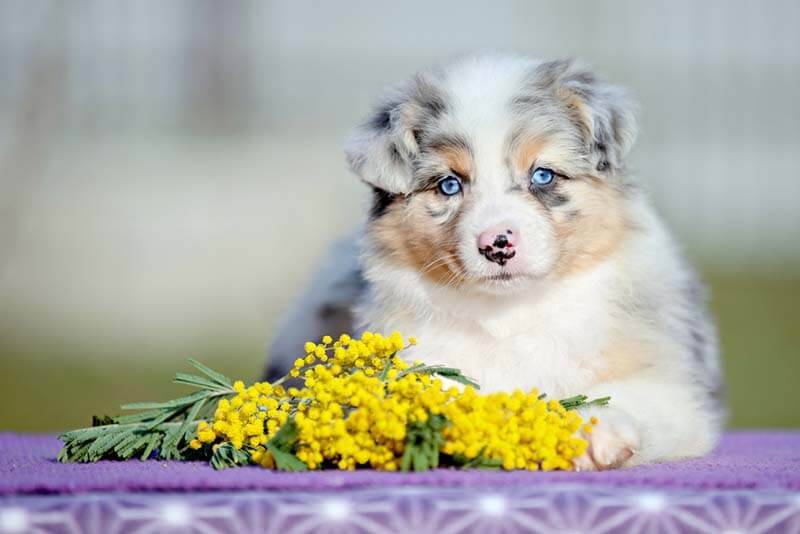
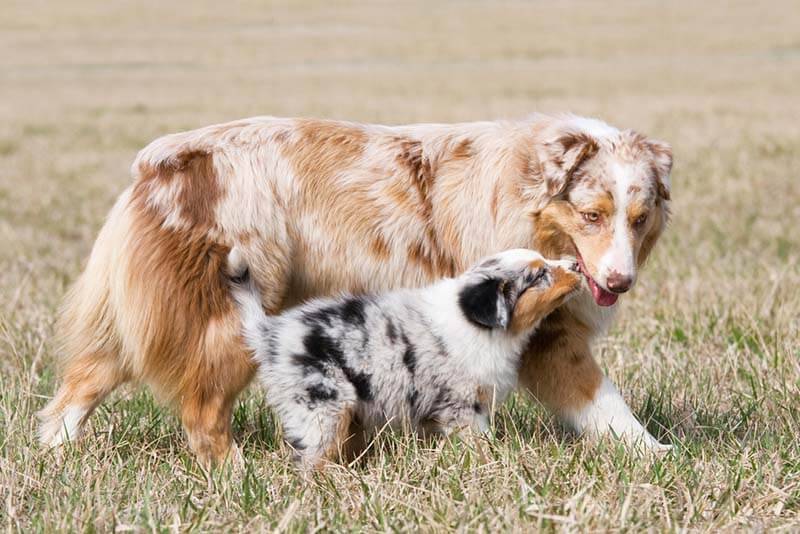
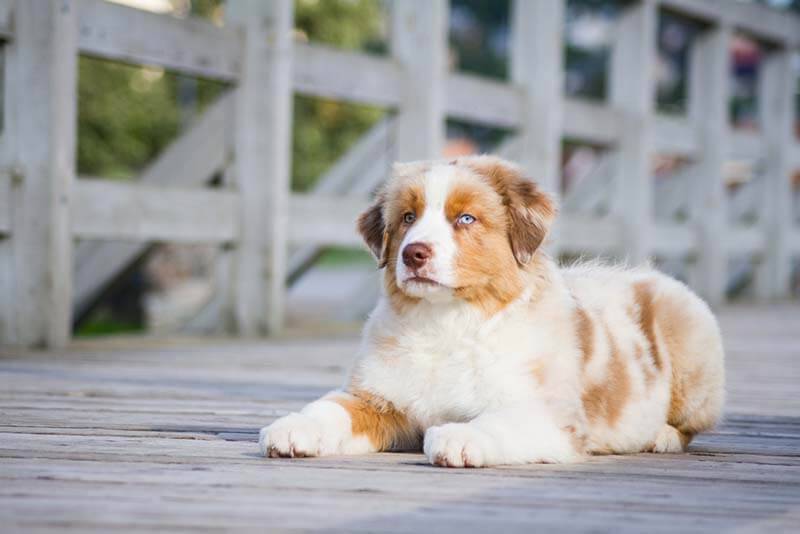
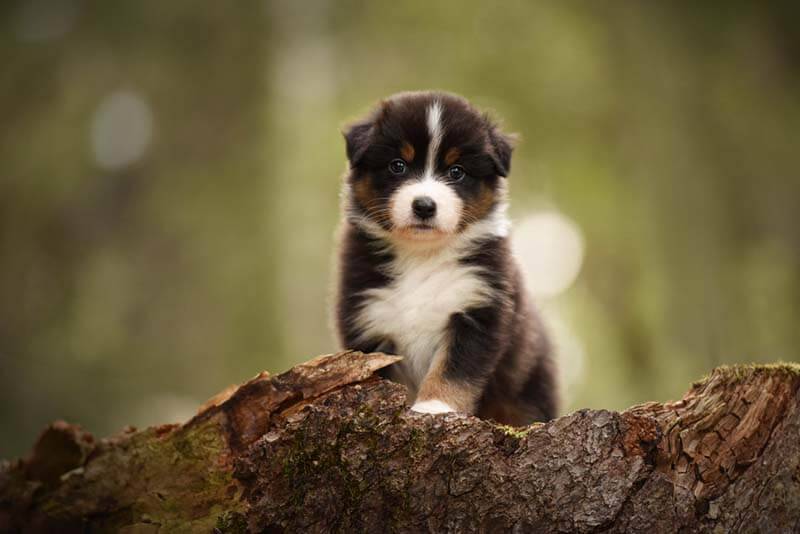
Australian Shepherd prices
Not many representatives of this breed are registered on the territory Our Country. All these dogs have an ideal pedigree and working qualities.
If you want to buy a purebred Australian Shepherd puppy, then get ready to pay at least 1000$. But such ideal dogs are needed only by those owners who are going to participate in exhibitions with them or plan to use them for breeding. If you want to find yourself a friend and a dog for the soul, you can save money and choose an animal with disqualifying vices. Very often they are color problems. But this does not affect the health and psyche of the dog. And the cost of the baby will be significantly cheaper.



